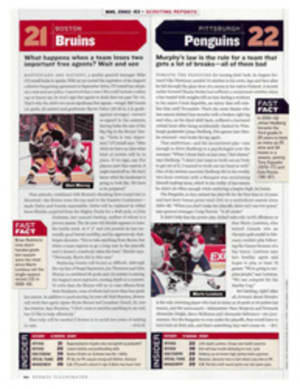
How Does He Do That? From leaping off rooftops and rock crops to riding down a 1,000-meter waterfall, extreme mountain biker Hans (No Way) Rey performs stunts that others haven't even dreamed of
Every once in a while, extreme mountain biker Hans Rey likes to go
up on the roof of his pretty little hillside house in Laguna
Beach, Calif., and take in the view over the wide blue Pacific.
He'll go down into his garage and from the 12 bikes there choose
maybe the gray GT Ruckus with the full suspension, take it into
his backyard, climb on, then bunny-hop it up 16 stairs to a deck.
From there he'll jump it onto a chaise, then onto the deck
railing, then onto the roof, where he'll do a front wheel stand
on the downslope, turn, ride up to the chimney, jump three feet
up and perch on the chimney top looking very much like some kind
of bicycle-factory weather vane. He'll finish with a chimney
wheelie that he maintains as he jumps back onto the downslope,
then converts into a front wheel stand before he shoots off the
gutter and 10 feet into the backyard pool, where he bobs up
smiling as if to say, "Bet you haven't seen that before."
In fact, Rey can do so many things on a bike that you haven't
even imagined, much less seen, that people have been trying for
years to come up with a handle that does justice to the range of
his two-wheel talents. He calls himself No Way Rey because, he
says, each time his friends in Laguna would dare him to try a
seemingly impossible jump, climb, downhill or rock-hop jig, they
would say, "No way you can do that, dude." Then he would go ahead
and do it. The media has called him the Wayne Gretzky of mountain
biking, the David Copperfield of mountain biking and, because of
how hard he works his shows, the James Brown of mountain biking.
All the sobriquets fit, but even together they don't catch what
this 36-year-old German-born Swiss can do on an aluminum frame
and two fat tires.
"When I do this, it's almost like a meditation," he said in
August in a Laguna beachside park as he sprang five feet onto a
wall, put his front wheel on a railing, then leaped six feet to a
picnic table. "You have to shut out everything around you and
visualize where you're going to go next. And you have to know
what could happen if you miss--where you could put your feet to
save yourself." He's a thin six feet, with receding brown hair,
and speaks with a soft German accent. "I'm not out to kill
myself," he said, doing a 180 on his way to a table on a lower
level. "In fact, I've had very few injuries."
There was, of course, the downhill race on Hunter Mountain, in
Hunter, N.Y., in 1992, during which he crashed at 45 mph into a
water barrel, breaking three ribs and puncturing a lung. And then
there was a much earlier injury that may have set him on his
career course. When he was four, at the family's home in the
Black Forest, his two older sisters put him on a tricycle and
pushed him down a flight of stairs. The ensuing wipeout left him
with a gashed head, but he found the ride a thrill. He started on
bikes at eight years old and at 12 began imitating motorcycle
trials riders on his BMX.
Trials riding, which is not nearly as well known in the U.S. as
it is in Europe, involves taking a motorcycle or a modified BMX
bike over a course of obstacles, which can include
teeter-totters, rocks, old cars or high thin edges of walls and
pipes. Falling or putting a foot down draws a deduction, adding
penalty seconds to the rider's time. At 16 Rey won the German
trials championship, the first of four in a row. He also took
three Swiss titles and in 1986 finished second in the world
championships and decided to retire. But in 1987 he moved to the
U.S. and, what the heck, as long as he was here, went ahead and
won the American trials title. He then won the worlds in '89.
"When I got to this country, mountain biking was starting to take
off, so I decided to use mountain bikes to do the trials stunts,
which up to then had been done only on smaller bikes," he says.
"Then I started making videos so I could show people what we did,
and they were a hit."
A couple with a young boy stopped on their way through the Laguna
park to watch as Rey flew the bike back to the wall, landed it on
the rear wheel and held it there like the Lone Ranger on a
rearing Silver.
"Wow," said the boy.
"Get down off the wall," said a cop walking by with his partner.
"You can't do that here--liability issues."
"Nice trick, though," said the partner.
The police here know Rey--he appeared as himself in several
episodes of the bike-cop television show Pacific Blue in the late
1990s--as do millions of people around the world because of his
other great talent: marketing himself.
"What most outdoor athletes don't understand," Rey says, "is that
it's a business. They don't understand that if a company gives
you money, it wants something back. I spend way more time
marketing and managing myself than I do on a bike. I'm promoting
myself 340 days a year."
Mountain biking icon Gary Fisher, a former rider who now designs
bikes, says that Rey "was the first to take the notion of doing
impossible stunts and marketing them. He was a forerunner in the
move away from motor-driven to human-driven X Games kind of
sports."
Among Rey's p.r. efforts is a slick book he puts together every
year for his dozen sponsors--among them Adidas, Swatch and
bicycle-maker GT--that catalogs his many shows and clinics, his TV
appearances, as well as the magazine articles and ads featuring
him. He also maintains a website that provides lessons, video, a
biography and reports on the Hans Rey Adventure Team.
The Adventure Team's seven TV documentaries have followed Hans,
and other bike athletes he has invited along, to Borneo to look
for headhunters, to Egypt to trace the wanderings of Moses, to
Peru to explore the Inca trail, to Jamaica to ride down a
1,000-meter waterfall, to Hawaii, to New Zealand, to South
Africa, to Cuba.
"They used to take mule and horseback to get to these exotic
locations," Rey says. "I wanted to do it on a mountain bike. I've
always had a big interest in archaeology and history and mystery.
In China we went looking for a tribe of totally miniature people
who, legend says, crashed in an alien spaceship 2,000 years ago.
The Chinese secret service wouldn't let us go where we wanted, so
we didn't see the miniature people, but the Chinese admitted the
tribe exists."
Rey's interest in the extraterrestrial dates to a UFO sighting he
says he and his mother shared in the late 1980s while on the deck
of their house in Switzerland. "If she hadn't seen it too, I
wouldn't believe it," he says of the sudden twilight appearance
of two saucers across a mountain valley. He is a member of the
Archaeology, Astronautics and SETI [Search for Extraterrestrial
Intelligence] Research Association and believes that conventional
archaeological theories don't tell the whole story of the Earth's
past. "It's not that I was going to solve the pyramid mystery,"
Rey says of his 2001 ride across the Sinai to the Red Sea, "but
I'm still hoping I'll have the big find.... I'm sort of the
Indiana Jones of mountain biking."
On the last Wednesday in August, Rey and 32 other members of the
Laguna Rads, a hard-core mountain bike group, met in Laguna
Canyon for their 19th annual Challenge Race. It's a
mile-and-a-half run up to the canyon ridge then a treacherous
descent through oak and chaparral to the finish. The overall race
and the downhill portion were to be timed separately, and Rey
chose to use different bikes for each half: a light one for the
uphill and a heavier, full-suspension model for the downhill. A
half-dozen competitors somersaulted off their machines on the
descent, and several of them got up bloody. Rey came in sixth
overall, thanks to a daring pass on a sweeping turn just short of
the finish. He won the downhill.
"I'm really not so much into competition anymore," he said as the
ragtag group had beer and burgers near the bottom of the run at
sunset, "but this is a rare old-time mountain bike gathering.
It's very hard to get into the Rads. It takes years, and one
negative vote among the 60 members keeps you out. They made me a
member my first year."
The next afternoon in his living room, with its groaning trophy
shelves, he told a story that seemed to suggest the only handle
that describes him adequately.
"I was in Chicago a few years ago doing a clinic for a group of
bike cops when these two bike messengers pulled up to watch. In
the middle of whatever I was doing, I heard one of them say, 'Who
does this guy think he is, Hans Rey?'"
Exactly: the Hans Rey of mountain biking.
COLOR PHOTO: STEFAN EISEND [INSIDE COVER] WILD WHEEL Hans Rey takes mountain biking over the edge SPOKESMAN Rey (here in Slovenia) was the first mountain biker to aggressively promote his stunts
COLOR PHOTO: PHOTOGRAPH BY BOB ALLEN PHOTOGRAPHY OVER THE TOP Rey had his Mojave mojo working during a high-flying off-road spring excursion to Twentynine Palms.
THREE COLOR PHOTOS: STEFAN EISEND (3) WHEEL MAN Whether skimming Austria's Rettenbach Glacier (top) or dropping in on a friend (bottom), Rey makes a splash.
TWO COLOR PHOTOS: BOB ALLEN PHOTOGRAPHY (2) [See caption above]
"Riding is almost like a meditation," says Rey. "You have to
shut out everything around you and visualize where you're going
to go next. And you have to know what could happen if you miss."

